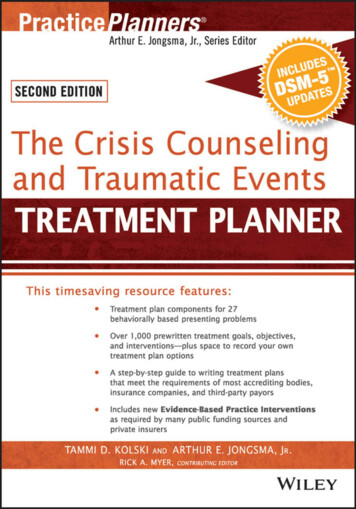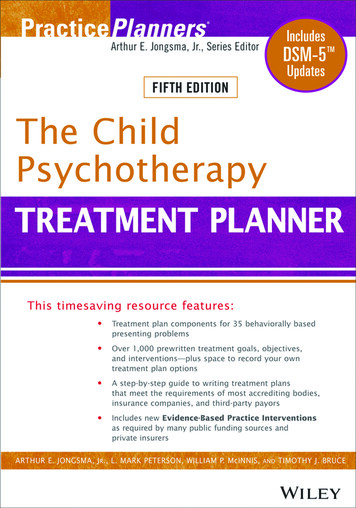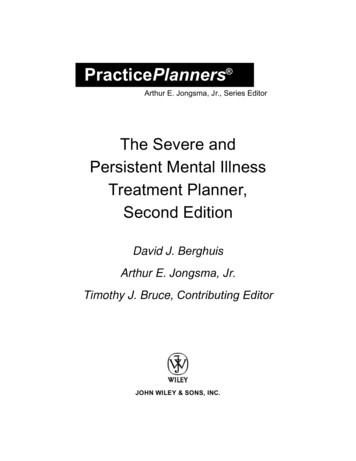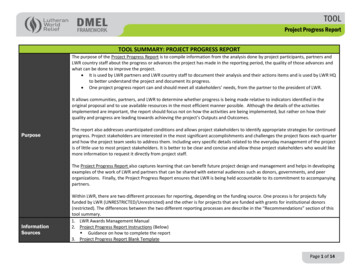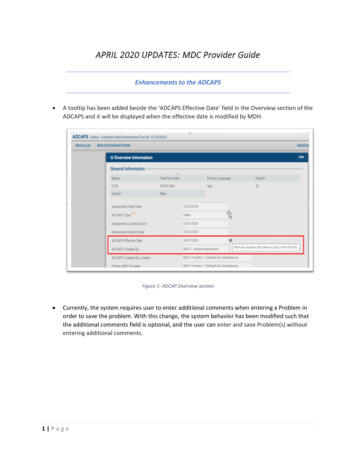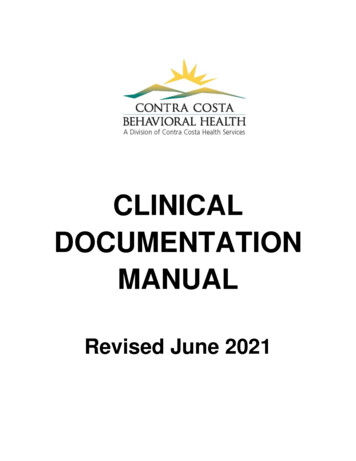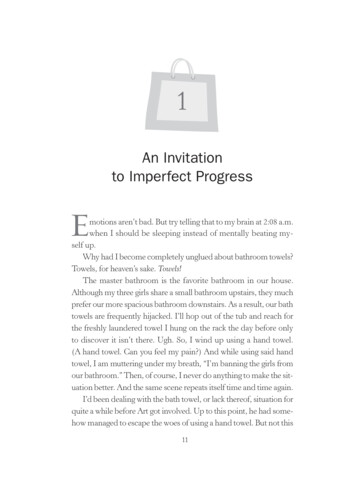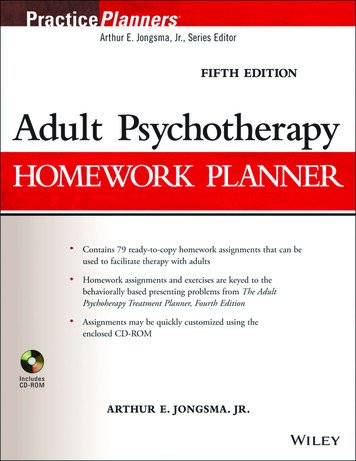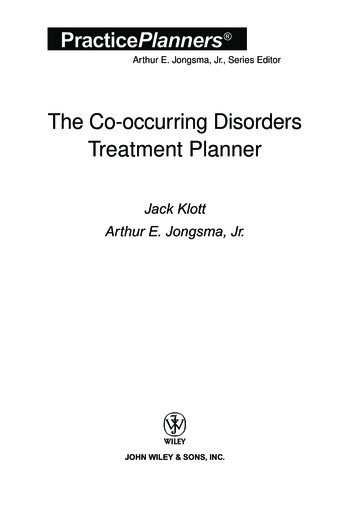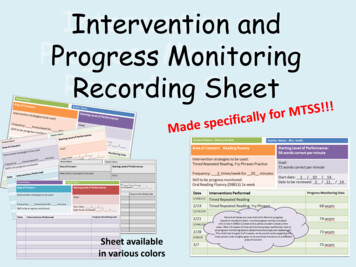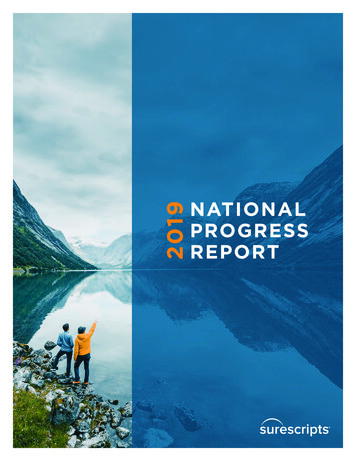
Transcription
2019 NATIONAL PROGRESS REPORT 1
READY FOR A FAST-MOVING FUTUREA LETTER FROM OUR CEOWe are in an unprecedented moment in history. The COVID-19 pandemic has rearranged livesand shifted priorities across the globe, and healthcare is at the center of the whirlwind.But American healthcare is used to rapid change. Throughout 2019, market forces, governmentactivity, and the expectations of new generations of patients and clinicians were alreadyspeeding us toward a world in which our industry must evolve quickly to succeed.It’s a world that’s pushing us to share information more efficiently, securely and transparently.As part of the 21st Century Cures Act, the federal government drafted new rules on informationblocking and interoperability. The latest data from the Office of the National Coordinatorfor Health Information Technology shows just 46% of U.S. hospitals and 10% of office-basedphysicians are able to electronically find, send, receive and integrate patient health informationfrom outside sources.1, 2 Clearly, there is more work to be done as provider organizations andtechnology vendors focus on meeting these new regulatory requirements throughout 2020.With drug pricing a hot topic across the nation, the federal government also issued a rulerequiring that Medicare Part D plans adopt real-time prescription benefit tools by 2021. Patientsand prescribers too are demanding prescription price transparency: 4 in 10 providers sayprescribing would be more efficient with more information at their fingertips, particularly costand coverage data.3 Meanwhile, 61% of patients say they’d be willing to spend extra time, effortor money in order to have informed prescription cost conversations with their doctor—onesignal that consumerism is finally taking hold in U.S. healthcare.4It’s also a world where healthcare costs, data and outcomes are more intertwined than ever.One insurer predicts that 59% of healthcare payments will be value-based by 2021.5 But as of2017, 24% of healthcare executives said they lacked the external interoperability needed forvalue-based care.6Controlling costs is further complicated by the rise of specialty drugs, which now account fornearly half of prescription drug spending.7 And cost is not the only barrier for the patients whoneed them. For many critical specialty medications, treatment can be delayed by days or weeksdue to factors such as prior authorization.As you navigate our 2019 National Progress Report, you might ask: Are we ready to navigatethese changes and see our way through to better, safer, less costly care?What I see indicates that we are making true progress on each of these fronts. Through a robustand trusted network, continual innovation and the deep engagement of partners across theSurescripts Network Alliance , we are delivering actionable intelligence to transform morehealthcare interactions and patient outcomes than ever before.Thank you for joining us as we explore how we enhanced prescribing, informed care decisionsand advanced healthcare together in 2019.2 2019 NATIONAL PROGRESS REPORT
THE SURESCRIPTS NETWORK ALLIANCETHE SURESCRIPTS NETWORK ALLIANCECONNECTING HEALTHCARE WITH SPEED AND PRECISIONToday, the Surescripts Network Alliance links virtually all electronic health records (EHR) vendors, pharmacybenefit managers (PBMs), pharmacies and clinicians—plus health plans, long-term and post-acute careorganizations, specialty hubs and specialty pharmacy organizations—with health data for the vast majority ofinsured U.S. patients and virtually all prescribers.1.78 million healthcareprofessionals andorganizations connected( 11% in 2019)0.04 seconds, on average,to retrieve an accuratepatient match314 million patients inour master patient indexrepresenting 95%* of theU.S. population*This includes patient data provided by both pharmacies and PBMs. In previous years, we only included patient data provided by PBMs.The data has been adjusted to account for duplication and patients with multiple coverage.MAINTAINING A TRUSTED, RELIABLE NETWORKAs the healthcare landscape shifted in 2019, SurescriptsNetwork Alliance participants could count on the strength,security and availability of our network.99.999% approximate uptimeHITRUST CSF Certified status maintained forkey platforms, demonstrating strong privacy,security and risk-management practicesand placing Surescripts in an elite group oforganizations worldwide10% increase in Quality Index Score forelectronic prescriptions across the network(an 80% improvement since 2016)Surescripts’ Quality Index Score measures the effectiveuse of 11 key elements of electronic prescriptions, such asDrug Description, Days Supply, and Potency Unit Code.2019 NATIONAL PROGRESS REPORT 3
THE SURESCRIPTS NETWORK ALLIANCEAPPROACHING 20 BILLION NETWORK TRANSACTIONSSurescripts processed 19.15 billion transactions in 2019, an 8% increase from 2018.19.15 BILLION20 BILLION17.7 BILLION8%INCREASE13.7 BILLION15 BILLION10.9 BILLION9.7 BILLION10 BILLION6.5 BILLION6 BILLION5 BILLION201320141.79 billione-prescriptions filled201520162.18 billion medicationhistory responses delivered201720182019333.8 million links to clinicaldocument sources sharedHistorically, Surescripts has reported on the number of prescriptions written electronically nationwide. Going forward, we will be reporting the numberof prescriptions filled by retail and mail-order pharmacies to more accurately reflect the state of industry progress. Surescripts estimates that 84% ofprescriptions written are dispensed.SPOTLIGHT: ELIGIBILITY & FORMULARYBy giving providers the ability to check a patient’s insurance and prescription benefit coverage, Eligibility& Formulary serves as the foundation for many Surescripts solutions, including E-Prescribing, Real-TimePrescription Benefit, Electronic Prior Authorization, Medication History and Record Locator & Exchange.3 billion eligibility responses ( 14% in 2019)An earlier version of the 2019 National Progress Report inadvertently listed eligibility response volume as 2.8 billion ( 4% in 2019).4 2019 NATIONAL PROGRESS REPORT
THE SURESCRIPTS NETWORK ALLIANCETRACKING & CELEBRATING PRESCRIPTION ACCURACYSince 2016, our Critical Performance Improvement program has convened the Surescripts Network Alliance toimprove the accuracy of e-prescriptions. Surescripts Sentinel analyzes electronic prescriptions and identifiesopportunities for improvement.In 2019, we recognized 12 health systems, EHRs and pharmacy industry leaders with the Surescripts WhiteCoat Award for their work optimizing e-prescribing.EHRSathenahealth, Inc.MDLiveCare Inc.MEDENTHEALTH SYSTEMSGreater Baltimore Medical CenterMidMichigan HealthMontage HealthNortheast Georgia Health SystemUniversity of California San Francisco HealthPHARMACY INDUSTRY LEADERSCVS HealthHumana PharmacyKeyCentrix Inc.Walmart Inc.GUIDING THE INDUSTRY TOWARD A NEW STANDARDThroughout 2019, we guided the industry’s migration to the National Council for Prescription Drug ProgramsSCRIPT Standard Version 2017071, required by the Centers for Medicare and Medicaid Services as of January 1,2020. Through hundreds of improvements to e-prescribing transactions, the new standard will:Reduce manual processes that disruptprovider and pharmacy workflowsEnrich medication history with additionaldata elementsLet pharmacies electronically requestprescriptions for medications they have notpreviously dispensed and readily transferprescriptions to other pharmaciesServe long-term and post-acute caresettings with transactions that lend longawaited clarity, automation and efficiencyto this unique marketThe majority of Surescripts Network Alliance participants that use E-Prescribing and Medication Historyhad certified to the new standard by the end of 2019, ahead of the Surescripts sunset date for SCRIPT v10.6.They included organizations responsible for:43.5% of e-prescriptionssent from EHRs99.9% of e-prescriptions processedby mail-order pharmacies89.4% of e-prescriptionssent by health systems92.2% of e-prescriptions processedby retail pharmacies2019 NATIONAL PROGRESS REPORT 5
ENHANCE PRESCRIBINGENHANCE PRESCRIBINGDELIVERING THE RIGHT MEDICATION WITHOUT DELAYE-PRESCRIBINGE-PRESCRIPTIONS FORCONTROLLED SUBSTANCESE-PRESCRIPTIONS1.74 BILLION1.49 BILLION1.91 BILLION1.64 BILLION2.1 BILLION1.79 BILLION3 BILLION77.33 MILLION65 MILLION115.16 MILLION 159.77 MILLION96.8 MILLION134.2 MILLION160 MILLION120 MILLION2 BILLION80 MILLION1 BILLION40 MILLION2017201820192017Written20182019FilledRATE OF E-PRESCRIBINGALL PRESCRIPTIONS201920182017NON-CONTROLLED SUBSTANCES80%73%66%86%83%76%201920182017CONTROLLED SUBSTANCES38%26%17%201920182017Note: Percentages calculated using data from the National Association of Chain Drug Stores.Historically, Surescripts has reported on the number of prescriptions written electronically nationwide. Going forward, we will be reporting the numberof prescriptions filled by retail and mail-order pharmacies to more accurately reflect the state of industry progress. Surescripts estimates that 84% ofprescriptions written are dispensed.E-PRESCRIBING 8.5%98.1%201920182017The number of prescribers utilizing E-Prescribing increased more than 8% in 2019.6 2019 NATIONAL PROGRESS REPORT79%73%69%
ENHANCE PRESCRIBINGSPOTLIGHT: CANCELRxIn 2019, we saw more and more clinicians implementing workflow and technology changes, like the CancelRxtransaction, to improve prescription accuracy and patient safety. By using CancelRx, prescribers can securelyand reliably notify the pharmacy of the need to cancel a prescription, which stops automatic refills andeliminates the need for time-consuming phone calls and faxes.CANCELRx TRANSACTIONS3.8 MILLIONPRESCRIBERS ENABLEDFOR CANCELRx11.8 MILLION35.8 MILLION40 MILLION47%29%13%20192018201730 MILLION20 MILLION203%INCREASE10 MILLION201720182019SPOTLIGHT: RxCHANGEPharmacists often play a critical role in optimizing medication therapy, and RxChange gives them a quicker,easier way to collaborate with prescribers. In 2019, the Surescripts network saw considerable growth in the useof RxChange, particularly three unique use cases, including RxChange for Prior Authorization, RxChange forTherapeutic Interchange and RxChange for Generic Substitution.RxCHANGE TRANSACTIONS84,000PHARMACIES ENABLEDFOR RxCHANGE11.7 MILLION12 MILLION34%6%6%2019201820178 MILLION4 MILLION201820192019 NATIONAL PROGRESS REPORT 7
ENHANCE PRESCRIBINGELECTRONIC PRESCRIBING FOR CONTROLLED SUBSTANCES (EPCS)In 2019, more healthcare professionals saw the safety and efficiency benefits of EPCS—and put it into action fortheir patients. Compared to 2018, 51% more prescribers were enabled for EPCS.PERCENT ENABLED FOR 2%22%201920182017TOP 5 SPECIALTIES USING SPAIN SFamily practice saw the largest increase, growing more than 7% in 2019.SPOTLIGHT: OPIOIDSIn response to the nation’s opioid crisis, opioidprescribing rates have been declining for severalyears now.8, 9 In 2019, we saw more opioidprescriptions written electronically, helpingguard against prescription fraud and abuse.E-PRESCRIPTIONS WRITTEN FOR OPIOIDS33.2 MILLION49.4 MILLION67.7 MILLION80 MILLION60 MILLION36%INCREASENote: This data includes opioid prescriptionswritten electronically. Other e-prescribing datain this report considers only prescriptions filled.40 MILLION20 MILLION20178 2019 NATIONAL PROGRESS REPORT20182019
ENHANCE PRESCRIBINGTOP 5 OPIOID E-PRESCRIPTIONS WRITTENIn 2019, five opioids accounted for 88% of all opioid e-prescriptions olBuprenorphineCodeine13.2%Other27.4%Note: Based on new electronic prescriptionsand approved renewals for opioids.EPCS LEGISLATION ON THE MOVEWith 13 states enacting e-prescribing requirements in 2019, more than half of all states now require e-prescribingfor opioids, all controlled substances or all prescriptions. As provider enablement for EPCS rises in these states,we can also expect further advances spurred by the Substance Use-Disorder Prevention That Promotes OpioidRecovery and Treatment (SUPPORT) for Patients and Communities Act, which requires that controlled substanceprescriptions covered under Medicare Part D be transmitted electronically as of January 1, 2021.WHERE IS E-PRESCRIBING REQUIRED BY LAW?Currently requiredfor all prescriptionsWill be requiredfor all prescriptionsCurrently required for allcontrolled substancesWill be required for allcontrolled substancesCurrently required for somecontrolled substances (e.g. opioids)Will be required for somecontrolled substances (e.g. opioids)EHR adoption requiredLegislation in progress2019 NATIONAL PROGRESS REPORT 9
ENHANCE PRESCRIBINGEPCS STATE ctronically11New h Dakota98.8%56.3%73.2%69North outh 48.4%39.8%1628Montana99.1%47.1%41.8%1719Rhode %2115Texas97.0%40.7%43.8%2213New istrict of 29.9%4138South Carolina98.0%31.3%26.1%4240New Mexico98.6%27.2%30.1%4341New West %15.3%5151Hawaii95.8%7.4%11.8%5252Virgin Islands33.3%15.4%0.0%5353Puerto Rico40.9%1.7%0.0%10 2019 NATIONAL PROGRESS REPORTHIGHLIGHTSNew York maintained itslongstanding positionas the nation’s leader inEPCS enablement, havingrequired e-prescribing forall prescriptions since 2016.Maine and Connecticutheld their ranks as secondand third in the nationfollowing controlledsubstance e-prescribingmandates that took effectin mid-2017 and January2018, respectively.Arizona delayed itse-prescribing requirementfor opioids until January1, 2020, but the state stillmade gains in 2019: It leaptfrom 11th place to fourth.Oklahoma saw the largestrank increase in the nation,moving up 18 spots in2019. Its e-prescribingrequirement was enactedin May 2018 and becameeffective January 1, 2020.
ENHANCE PRESCRIBINGHOW STATE MANDATES SPUR EPCS ENABLEMENTPA ’s mandate tookNY , ME , and CT started the year with mandatesin place. So did MN , though its requirement hasAZ , FL , IA , NC , OK and RIhad mandates set to take effectJanuary 1, 2020.effect October 24, 2019.no specific penalties for TRONIC PRIOR AUTHORIZATIONIn 2019, Surescripts continued to focus on improving the prior authorization experience by streamliningworkflows and expanding our network to include new data suppliers.We also worked closely across the industry to build alignment around automating and improving the processfor patients and providers. Just after the new year, America’s Health Insurance Plans announced that it wouldleverage Surescripts Electronic Prior Authorization as part of its Fast Prior Authorization Technology Highway(Fast PATH) initiative, with the potential to benefit the 60 million patients covered by participating plans.10PBMs and health plans representing95% of U.S. patients have contractedto provide data for the service82% of U.S. prescribers served byEHRs contracted for the service58% increase in provider adoption132% increase in prior authorizationsprocessed electronically2019 NATIONAL PROGRESS REPORT 11
ENHANCE PRESCRIBINGREAL-TIME PRESCRIPTION BENEFITPatients and clinicians value prescription price transparency, and data shows that far more of them experiencedit firsthand in 2019.88% of U.S. prescribersserved by contractedEHRs ( 10% in 2019)PBMs and health planscovering 79% of U.S. patientshave contracted to providedata for the service.REAL-TIME PRESCRIPTIONBENEFIT CHECKS3.1 MILLION 2 seconds average timefor prescribers to receivecost and coverage datain their EHRPRESCRIBERS USING REAL-TIMEPRESCRIPTION BENEFIT40.5 MILLION136.1 MILLION160 MILLION2,600107,800251,100300,000120 MILLION200,00080 MILLION336%INCREASE40 AVERAGE SAVINGS PER PRESCRIPTION WHEN A LOWER-COST ALTERNATIVE IS CHOSENBY PROVIDER SPECIALTYBY THERAPEUTIC CLASSFAMILY PRACTICE 56ANTIMYCOTICS(FOR SYSTEMIC USE) 73INTERNAL MEDICINE 35ANTIDEPRESSANTS 35OBSTETRICS AND GYNECOLOGY 78LIPID MODIFYING AGENTS 16PSYCHIATRY 89BLOOD GLUCOSE LOWERING MEDICATION(EXCLUDING INSULIN) 53CARDIOLOGY 16BETA BLOCKERS 10Note: Listed in order of volume. Classification based on pharmacologic class.12 2019 NATIONAL PROGRESS REPORT
INFORM CARE DECISIONSINFORM CARE DECISIONSGIVING CARE TEAMS A CLEARER VIEWMEDICATION HISTORYIn addition to delivering more medication insights in 2019, we also introduced technical improvements toeliminate redundant records and augment medication history data, ultimately improving usability and accuracy.MEDICATION HISTORIESDELIVERED*1.46 BILLIONMEDICATION HISTORIES FORPOPULATIONS DELIVERED1.77 BILLION2.18 BILLION2.25 BILLION355,0001.9 MILLION5.7 MILLION6 MILLION19%INCREASE1.5 BILLION4 MILLION750 MILLION198%INCREASE2 MILLION201720182019201720182019Medication History for Populations lets healthcare providers proactively access medication history via theirEHR or analytics platform to help identify and close gaps in care, uncover medication non-adherence andmanage at-risk patient populations.* Includes only medication history data supplied by pharmacy benefit managers.RECORD LOCATOR& EXCHANGERecord Locator & Exchange played a keyrole in enabling interoperability in 2019,helping more clinicians and their patientsbenefit from more complete clinicalhistories during care episodes.CLINICIANS UTILIZING RECORDLOCATOR & ASE80,00040,0002017201820192019 NATIONAL PROGRESS REPORT 13
INFORM CARE DECISIONSCARE LOCATIONSUMMARIES DELIVEREDLINKS TO CLINICAL DOCUMENTSOURCES DELIVERED15.7 MILLION107.5 MILLION333.8 MILLION65 MILLION400 MILLION160 MILLION300 MILLION120 MILLION98.6 MILLION143.2 MILLION45%INCREASE200 MILLION80 MILLION211%INCREASE100 MILLION40 MILLION201720182019201720182019CLINICAL DIRECTMESSAGINGCLINICAL DIRECT MESSAGES TRANSMITTEDIn 2019, the use of Clinical Direct Messagingexpanded to include more individual users andnew use cases. For instance, one PBM used ClinicalDirect Messaging to alert prescribers to formularychanges. Pharmacies used it to alert doctors whentheir patients received a flu shot at a pharmacy.60 MILLIONIn total, more than 648,000 individuals andorganizations—including nearly 24,000pharmacies—used Clinical Direct Messaging in2019, a 9% jump from 2018.25.9 MILLION31.4 MILLION37.7 MILLION45 MILLION30 MILLION20%INCREASE15 MILLION201720182019INSIGHTS FOR MEDICATION ADHERENCEInsights for Medication Adherence provides patient insights with data from PBMs and others. For instance, if apatient filled prescriptions for opioid analgesics from at least three prescribers in the last 90 days, Insights forMedication Adherence could help clinicians recognize suspicious prescribing activity and intervene. It was alsoused to spot unsafe overuse of certain therapies, such as flagging a patient with a supply of benzodiazepines,muscle relaxants and opioids in the last 45 days.In 2019, Insights for Medication Adherence supported more than 120,000 clinical interventions.14 2019 NATIONAL PROGRESS REPORT
ADVANCE HEALTHCAREADVANCE HEALTHCARERESEARCHING AND ADVOCATING FOR THE USE OF HEALTH ITWorking at the intersection of so many national healthcare issues gives Surescripts a unique opportunity toadvance our collective knowledge through original research and data analysis. In 2019, we paid special attentionto the role of EPCS in combating the opioid epidemic and opportunities to improve the process of prescribingspecialty medications.EPCS RESEARCHWith the SUPPORT Act requiring electronic prescribing for all controlled substance prescriptions covered byMedicare Part D by 2021, we’re seeing increased use of EPCS among Medicare Part D providers. We worked withthe Office of the National Coordinator for Health IT to study their use of EPCS between 2015 and 2016.During this time period, the proportion of all Medicare Part D prescribers using EPCS increased from 4%to 11% while Medicare Part D opioid prescribers using EPCS more than doubled, rising from 5% to 13%. Painmanagement specialists had the largest proportion of EPCS utilizers, with 21% transmitting their controlledsubstance prescriptions electronically.11 The results of this research help us understand which areas of medicineand the country are seeing the most EPCS use and better forecast its growth through and beyond 2021.SPECIALTY PRESCRIBING RESEARCHWe entered 2019 well aware of the complexity of specialty prescribing, and further research illuminated theparticular challenges prescribers face when prescribing specialty drugs. We surveyed healthcare providers abouttheir experience writing specialty prescriptions and identified two primary pain points: a lack of key informationin drug selection and the burdensome manual prescribing process.12On average, providers spend more than three hours a week on paperwork—not including charting—in order tostart a patient on a specialty medication. The time and administrative burden has a domino effect: Nearly 40% ofproviders said it typically takes one to two weeks to actually get that medication to the patient.Unsurprisingly, only 29% of providers are extremely or very satisfied with their organization’s efficiency whenprescribing specialty medication. This inefficiency can also result in wasted work for pharmacies. Whenphysicians encounter barriers to prescribing, two-thirds simply change or reroute their orders.Taken as a whole, our research shows ample opportunity for improving how we handle specialty prescriptions,where the costs are often as high as the impact on patients’ lives. We are already incorporating these insightsinto the solutions we build, and we look forward to seeing statistics like these shift as better processes take holdacross the Surescripts Network Alliance.2019 NATIONAL PROGRESS REPORT 15
1.2.3.4.5.6.7.8.9.10.11.12.Yuriy Pylypchuk et al., “State of Interoperability Among U.S. Non-federal Acute CareHospitals in 2018,” ONC Data Brief no. 51 (March 2020), 2018-11/Interop%20variation 0.pdf.Vaishali Patel et al., “Variation in Interoperability Among Office-Based Physicians in2015 and 2017,” ONC Data Brief no. 47 (May 2019), ffice-BasedPhysicians-in-2015-and-2017.pdf.Engine Group and Surescripts, survey of 502 U.S. physicians and nurses conducted inOctober/November 2018.Surescripts, “Prescription Price Transparency and the Patient Experience,” February2020, p. 3, elease-library/2020price-transparency data-brief-patient-survey.pdf.Aetna, “2018 Health Care Trends,” February 20, 2018, p.6, th-health-care-trends-2018.pdf.Humana, “Research Report: Value-Based Payment Readiness,” HMFA.org, March 31,2018, tml.“2019 Drug Trend Report,” Express Scripts, accessed March 23, 2020, nd-report#2019-in-review.Abigail Zuger, “Nationwide U.S. Opioid Prescribing Trends,” NEJM Journal Watch,March 14, 2019, de-us-opioidprescribing-trends.Bridget Kuehn, “Declining Opioid Prescriptions,” Journal of the American MedicalAssociation 321, no. 8 (February 26, 2019): 736, 2725700.Cathryn Donaldson, “New Fast PATH Initiative Aims to Improve Prior Authorizationfor Patients and Doctors,” AHIP.org, January 6, 2020, ctors/.Christian Johnson et al., “Electronic Prescribing of Controlled Substances amongMedicare Part D Prescribers 2015–2016,” ONC Data Brief no. 44 (April 2019), 2019-04/SurescriptsPartDDataBrief 0.pdf.Surescripts, “Provider Perspectives on Specialty Prescribing,” April 2019, t-document-library/2019 04 specialtyprescribing-data-brief.pdf.Our purpose is to serve the nation with the single most trusted and capable health information network, built to increasepatient safety, lower costs and ensure quality care. Since 2001, Surescripts has led the movement to turn data into actionableintelligence and convened network participants to enhance e-prescribing, inform care decisions and advance healthcare.Visit us at surescripts.com and follow us at twitter.com/surescripts.16 2019 NATIONAL PROGRESS REPORTMKTG 6386 March 2020 Copyright 2020 by Surescripts, LLC. All rights reserved.
(an 80% improvement since 2016) *This includes patient data provided by both pharmacies and PBMs. In previous years, we only included patient data provided by PBMs. The data has been adjusted to acc

